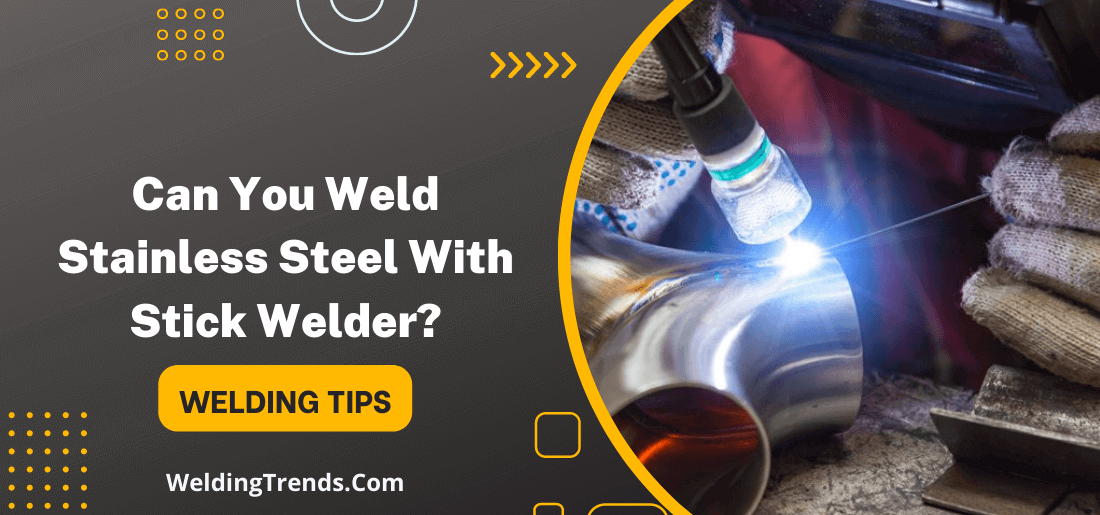Stainless steel is a corrosion-resistant alloy that contains chromium and nickel. It is commonly used in manufacturing, food processing and chemical industries because of its superior resistance to corrosion and hygienic properties.
Although stainless steel is often welded with a MIG welder or TIG welder and Yes it can also be welded with a stick welder.
In this blog post, we will discuss the welding process and how to weld stainless steel with a stick welder. Stay tuned!
How to weld stainless steel with a stick welder?
When welding stainless steel with a stick welder, it is important to use the correct electrode. Stainless steel electrodes are classified according to their position in the weld pool.
1) The most common type of electrode for welding stainless steel is the E308L-16, which is used for all positions. This electrode has a low carbon content, making it ideal for welds that will be exposed to corrosive environments.
2) Another common electrode is the E309L-16, which is used for welding in flat and horizontal positions. This electrode has a higher carbon content, making it better suited for welding thicker materials.
For both of these electrodes, the “-16” indicates that they can be used with direct current (DC) or alternating current (AC).
3) There are also electrodes specifically for welding in the vertical down position such as the E312-16.
When choosing an electrode, it is also important to consider the amperage range and the duty cycle of the welder. The amperage range is the range of currents that the welder can produce and the duty cycle is the percentage of time that the welder can be operated at its maximum output.
For welding stainless steel, a welder with an amperage range of 40-250 amps and a duty cycle of 60% or higher is best.
To begin welding, set the welder to the correct amperage and position the electrode so that it is at a 90-degree angle to the workpiece. For welding in the flat or horizontal position, hold the electrode parallel to the workpiece. For welding in the vertical down position, hold the electrode perpendicular to the workpiece.
Strike an arc by touching the electrode to the workpiece and then quickly moving it away. The arc should be about 1/8″ long. Once the arc is established, maintain a steady pressure on the electrode while keeping it at a 90-degree angle to the workpiece.
While welding, keep the electrode tip clean by periodically dipping it into the flux. This will help to prevent the electrode from becoming clogged and improve the quality of the weld.
When you reach the end of the weld, stop welding and allow the arc to cool before breaking it. This can be done by moving the electrode away from the workpiece or by depressing the welder’s trigger.
Let the weld cool for a few minutes before inspecting it. If any areas need to be re-welded, use a grinder to remove them and then re-weld those areas.
Stick welding is a great way to weld stainless steel and with the right electrode, it can produce high-quality welds that are strong and corrosion-resistant.
Advantages of using stick welder to weld stainless steel:
- The process is relatively simple and does not require expensive equipment.
- Stick welding can be used on a variety of materials, including stainless steel.
- With the proper technique, it can produce high-quality welds that are strong and corrosion-resistant.
Disadvantages of using stick welder to weld stainless steel:
- Process can be slow, and it is not suitable for welding large areas.
- Quality of the welds depends heavily on the operator’s skill level.
- It is not possible to create welds that are invisible or have a clean finish.
- Process produces a lot of fumes and smoke, which can be dangerous to the operator’s health.
If you are considering using a stick welder to weld stainless steel, be sure to read the manufacturer’s instructions carefully and practice welding on scrap pieces of metal before attempting to weld on your workpiece.
Things you need to know before welding stainless steel with a stick welder
Before you weld stainless steel with a stick welder, there are a few things you need to know.
- First, stainless steel is highly resistant to corrosion and welding can cause it to become even more susceptible. This means that you’ll need to take extra care when preparing your work area and materials.
- Second, stainless steel tends to be very hard, so you’ll need to use a more powerful welder and thicker rods.
- Finally, stainless steel emits harmful fumes when welded, so be sure to work in a well-ventilated area and wear a respirator.
Tips for welding stainless steel with a stick welder
Following are tips for welding stainless steel with a stick welder:
- Use an electrode that is compatible with the base metal. In most cases, this will be a 309 or 312 stainless steel electrode.
- Use a low hydrogen welding rod, such as 7018.
- Preheat the base metal to at least 300 degrees Fahrenheit before beginning to weld.
- When welding, use short, consistent strokes and maintain a steady arc length. Avoid stopping and starting the weld, as this can cause the formation of cracks.
- Allow the weld to cool slowly after welding is complete. Do not quench in water or apply too much force when cooling, as this can cause the weld to break.
By following these tips, you can help ensure that your stainless steel welds are strong and free of defects.
If you have any questions about welding stainless steel, be sure to consult with qualified welding professional.
FAQs – weld stainless steel with stick welder
Can you weld stainless steel with 6011 rods?
Yes, you can weld stainless steel with 6011 rods. 6011 rods are often used for welding stainless steel because they provide good penetration and have a low hydrogen content, which helps to prevent cracking.
Can you stick weld 304 stainless steel?
Yes, you can stick weld 304 stainless steel. You can weld just about any type of stainless steel with the right welding rod and a few other supplies.
However, 304 stainless steel is particularly easy to weld because it is not as hard as other types of stainless steel. This means that it will not require as much heat to melt the metal, making it easier to weld.
Can you stick welding stainless steel to mild steel?
Yes, you can weld stainless steel to mild steel. However, there are a few things you need to keep in mind.
- First, you need to use a filler material that is compatible with both metals.
- Second, you need to be careful not to overheat the stainless steel, as this can cause it to become brittle and break.
- Finally, you need to make sure that the weld area is clean and free of any contaminants before welding.
Can I use a 6013 welding rod on stainless steel?
Yes, you can use a 6013 welding rod on stainless steel. However, it is important to note that this type of welding rod is not recommended for use on aluminum or other metals.
Additionally, it is important to follow all safety precautions when using any type of welding rod.
Wrap Up
Yes, you can weld stainless steel with a stick welder. While it may not be the ideal welding process for this type of metal, it can be done if you have the right equipment and know how to use it properly.
However, it takes practice and patience to get good results. If you’re new to welding stainless steel, start by practicing on some scrap metal until you feel comfortable with your technique. With a little bit of practice, you’ll be able to create beautiful welds that will last for years.




